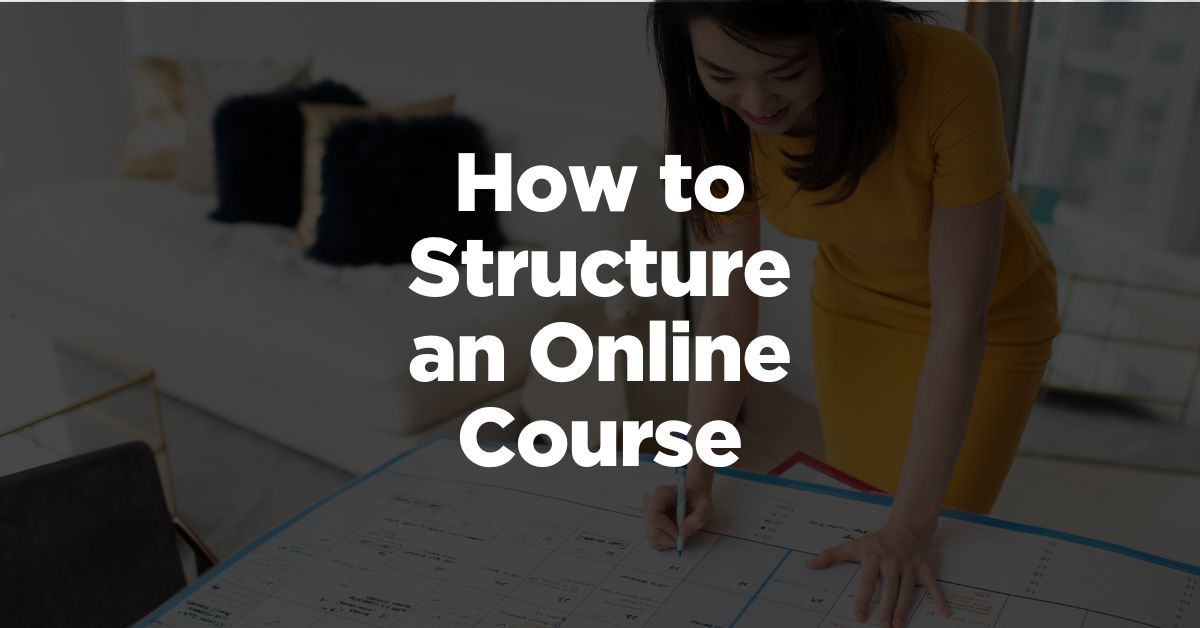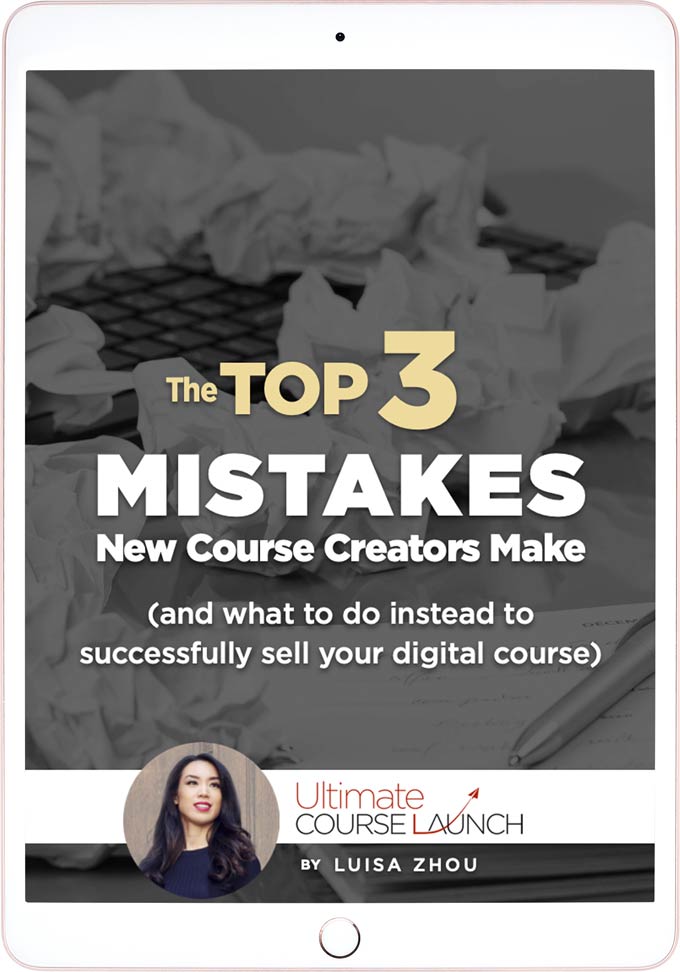How do you structure an online course?
Online courses help you build a business or grow your existing business. But first, you need to sell a course people want to buy.
How? Read on!
1. Define your target audience and learning outcomes
The online course market is huge. In fact, the global e-learning industry is expected to reach $325 billion by 2025. So to make your course stand out, you need to create the best possible course for your niche audience.
How? First, you need to understand who they are.
See, your target audience affects your teaching style, content format, and how you organize your content.
For example, say you’re creating a course about how to make a chocolate cake. If your course is for complete beginners, then you will spend more time explaining technical terms and basic techniques. Compare that to a course for pastry chefs. That course would include way more technical details and advanced techniques.
So figure out:
Discover the top 3 reasons most courses fail
(plus how to fix them so you succeed)
- What is their ultimate goal?
- What do they already know about your chosen topic?
- What are their challenges?
One of the best ways to research these questions is to work with a few coaching or consulting clients.
That way, you’ll get to know exactly what your ideal students are struggling with and the problems you can solve with your course.
Because that’s key: every successful online course needs to solve a problem.
And that problem not only has to be helpful, but it also needs to be worth paying for.
For example, some people wouldn’t pay for a course on how to knit. But other people really value that skill and would invest in a course that teaches them how to knit.
So think about why your course is valuable and who it would be valuable to.
Now let’s talk about learning outcomes.
Learning outcomes are what your audience can expect to learn from taking your course.
In short, what is the transformation you offer?
Even if what you’re teaching is not that tangible, that’s okay. There’s still going to be some kind of tangible result.
For example, if you’re teaching a course on how to feel happier throughout your day, get clear on what will change in your students’ daily lives to make them feel happier.
So focus on the results. This will help you design a course that gets your students to their end goal in the easiest and fastest way possible.
Once you’ve figured out the main learning outcomes of your course, it’s time to break that down into milestones, which we’ll look at in the next step.
And for more on identifying your course’s end result, check out this video:
2. Create a course outline
Now you’ve got an idea of the learning outcomes, you can create a more detailed outline.
You want to identify the main milestones that your student needs to achieve to get to their overall goal.
So let’s say you’re designing a course to help someone get a new job like my student Emily Liou did with her course Happily Hired.
The first milestone might be to get clear on exactly what type of career they want.
Think of it like a path. What are the specific steps and milestones that will get your student from A to Z? You can draw out the steps on the path and that becomes your course outline.
This logical step-by-step method is the most common way of organizing the key milestones of your course.
But there’s another method.
You can also organize your content into “areas of mastery.”
So instead of a linear path step-by-step, your milestones are focused on mastering one area of the overall goal – like a puzzle piece.
For example, if you’re creating a course on yoga, you might organize your content around the different types of poses, with one module each on standing poses, sitting poses, dynamic poses, and so on.
Your student has to master each of the benchmarks to get to their final goal. But they don’t have to take the course in order to get value. They could even focus on one of the areas they struggle with the most.
Whichever method you choose, mapping out the areas of mastery or the steps on the path will tell you exactly what each module should include.
I talk more about how to structure an online course in this video:
Once you have a skeleton you can easily fill in, creating the content is way easier.
So what should your course outline include?
Here’s a rough guide:
Course name: What will you name your course? Don’t overthink it.
Course description: What is your course about? What is the end goal?
Modules: What is the subject of each module?
Lessons: Define the topic of each lesson within the modules.
Bonuses: What bonuses will you offer to students?
Let’s dive a little deeper in the next section.
3. Structure the course in modules and lessons
So let’s translate those milestones into modules and lessons.
To start, a common mistake I see first-time course creators make is including way too much information. Yes, there is such a thing as too much information.
Think of it this way:
Your students are investing in your course because you’re making it easier to get their goal.
Too many lessons and PDF workbooks are just overwhelming.
Instead, you want to streamline your content in the most logical, step-by-step way possible.
First, modules.
Each module should line up with completing a milestone on the way to achieving the ultimate goal.
That means that some modules will be bigger than others.
For example, let’s say you’re creating a course about learning the guitar. The module explaining chords may be bigger than the module about tuning the guitar.
That’s where lessons come in. Your lessons break up your modules into digestible chunks.
So when structuring your lessons, think about:
- The introduction: At the beginning of each lesson, introduce the topic and let students know what they’ll learn in the lesson.
- Results-focused content: Make the meat of your lessons results-focused.
- Summary: Summarize the main takeaways of the lesson and what action steps your students should take to progress to the next level.
So how many lessons and modules should you have in your course?
A great structure is 4-8 modules. And each module should have no more than 3-7 lessons.
This structure has just enough information to be easy to implement and high-value for your students.
Finally, let’s talk about the supporting materials.
PDF workbooks, checklists, trackers, implementation guides, quizzes, and so on. These are extra materials that help your students achieve their goals.
It’s even better if the material is action-based. So plan out the list of materials you’ll include in each module. And remember, you don’t have to include a ton of materials in each module to make the course valuable. Only information that will make a difference to your student’s journey.
Next up: delivery.
4. Choose the right content delivery methods
You can format your course in multiple different ways:
Discover the top 3 reasons most courses fail
(plus how to fix them so you succeed)
- Slideshows
- Straight-to-camera videos
- Screen captures
- Audio clips
- PDF downloads
- Text
- Images/infographics
- Emails
When it comes to delivery, the method isn’t everything.
What matters most is the content.
At the same time, you want to choose a delivery method that works for your audience.
For example, if your course is aimed at young people, video and short text will work better than email.
It also depends on your course content.
Most people who buy a course on learning to play the piano probably expect to see video tutorials rather than text explanations.
However, your delivery doesn’t need to be super high-end. Of course, create the best quality content you can with the resources you have. But you can do a lot with your smartphone.
You can even create a slide deck and record your voice walking people through the lessons in a video. That’s a super easy way of delivering your course that still provides your students with great value. You can always upgrade the format (if you need to) once you break even on your course.
As a general rule, the most high-value formats are video and audio. Combine those with PDF downloads and you have a high-ticket course that your students will enjoy.
Now let’s talk about user experience.
5. Make the course easy to navigate
When thinking about how to structure an online course, many people forget about user experience.
But here’s the thing. The easier your course is to implement, the better the results your students will get.
Better results mean amazing case studies you can use to sell your course in the future.
So investing time in your course’s user experience is always worth it.
Think about how easy it is to go through your course.
That means:
- Is everything well explained?
- Is the platform you’re using easy to navigate?
- Is it easy for students to track their progress?
- How well does one module build on the previous one?
- Are the action steps simple to implement? If not, are there smaller steps you can add to make it easier?
Answering these questions will help you design a course that gets your students to the finish line in the most efficient way possible.
My advice? Create an overview in the first module of the course and the learning objectives.
This establishes exactly what your students are going to learn at each milestone and how to get the most out of the course.
Then, at the end of every module, recap what they’ve learned and what they’ll learn in the next module.
This helps reinforce what your students have learned so far and encourages them to complete the course.
Next up: bonuses and homework.
6. Add bonuses and assignments
One of the best ways to increase the value of your course is to add bonuses.
Your bonuses should be extra material that helps people implement your course and get results faster. They don’t need to be videos or PDFs, but they could be services, too – like group coaching calls.
Ultimately, bonuses make your course feel like a no-brainer to prospective students. They make the experience better for your students and make your course overall more valuable.
So what makes a good bonus?
Examples include:
- Scripts (such as interview scripts for job searchers)
- Templates (such as meal plan template for people designing their diet)
- Case studies (such as success story of how one of your previous clients achieved their goal)
- Bonus lessons (such as exclusive video on how to nail an interview for corporate employees looking for their dream job)
- Free membership (such as an exclusive space for your students to connect)
- Coaching sessions (such as one on one time with you to help them achieve their goal, group coaching calls, or group chats)
The bonuses you choose depend on your course topic and the amount of support you want to give.
The only rule is that the bonus should be relevant to the course and add a lot of value.
Another “extra” you can include are assignments. I personally don’t use assignments or homework in my own courses, but if you have a course that requires people to retain information, you can add quizzes at the end of each lesson or module.
And what if you don’t know what bonuses or assignments to include? After launching your course, student feedback will help you figure out what you can offer.
And to use student feedback, read on.
7. Use student feedback
Once your course has launched, the work doesn’t stop there. Now you can improve and perfect your course using the number one resource: student feedback.
Listen, creating my flagship course – Employee to Entrepreneur – was a great experience. I got to help so many people achieve their goals of becoming an entrepreneur.
But even though the first version of the course was well-received, it took me almost three years to perfect it.
Why? Because I continuously listened to my students over the years and incorporated their feedback in the next version.
Improving your course could mean:
- Switching formats
- Clarifying things
- Adding or removing content
- Adding new bonuses or supporting material
All of this makes your course the best possible product it can be so you can continue to make profits.
Now, you don’t have to look for negative feedback.
If something is wrong with your course, like a link isn’t working, someone will tell you straight away.
But if your course is pretty good as it is, how do you get student feedback to help you make it even better?
Simple: ask them.
Email your students directly or post in a community space about what you could improve with your course.
Ask questions like:
What was your favorite part of the course and why?
What was your least favorite part of the course and why?
Do you think there is something missing from the course?
Was the course easy to follow and implement?
Did you complete all of the assignments in the course? Why or why not?
What did you think of the course bonuses?
What are your results from taking the course?
Would you recommend the course to others? Why or why not?
Student feedback is what makes your course the best possible product on the market for your niche and helps you achieve financial freedom. So don’t skip this step!
Online course structure template
So now you know how to build your own successful online course.
Here’s a structure you can use for your course to get you started:
Online course outline example
Module 1: Introduction
- Lesson 1: Welcome
- Lesson 2: Course Overview
- Lesson 3: Learning Objectives
Module 2: Topic 1
- Lesson 1: Introduction to Topic 1
- Lesson 2: Subtopic 1
- Lesson 3: Subtopic 2
- Lesson 4: Overview / assignments
Module 3: Topic 2
- Lesson 1: Introduction to Topic 2
- Lesson 2: Subtopic 1
- Lesson 3: Subtopic 2
- Lesson 4: Overview / assignments
Module 4: Conclusion
- Lesson 1: Course Review
- Lesson 2: Next Steps
Next steps
Discover the top 3 reasons most courses fail
(plus how to fix them so you succeed)
And that’s how to structure an online course!
But having a well-structured course is just the beginning.
Creating an online course is simple…but it’s not easy. There are plenty of mistakes new course creators make all the time. And those mistakes could keep you from launching a successful course.
Want to know what they are?
Download my free guide on the 3 most common mistakes course creators make and how to avoid them.
Read more:
How to Create a 6-Figure Online Course
How to Sell High-Ticket Courses
How to Launch Your Online Course









